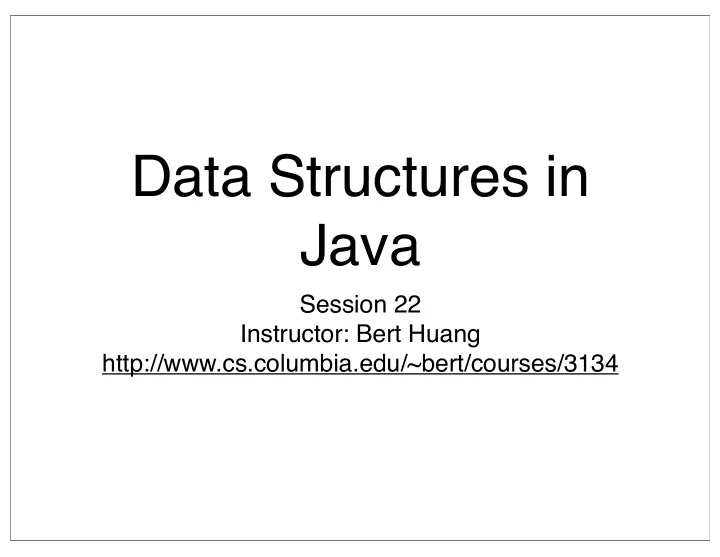

Data Structures in Java Session 22 Instructor: Bert Huang http://www.cs.columbia.edu/~bert/courses/3134
Announcements • Homework 5 solutions posted • Homework 6 to be posted this weekend • Final exam Thursday, Dec. 17 th , 4-7 PM, Hamilton 602 (this room) • same format as midterm (open book/notes) • Distinguished Lecture: Barbara Liskov, MIT. Turing Award Winner 2009. 11 AM Monday. Davis Auditorium, CEPSR/Schapiro
Review • Sorting Algorithm Examples • QuickSort space clarification • External sorting*
Today ʼ s Plan • Correction on external sorting • Complexity Classes • P, NP, NP-Complete, NP-Hard
External Sorting Disk 3 Disk 2 Disk 1 Disk 0
External Sorting Disk 3 Disk 2 Disk 1 Disk 0
External Sorting Disk 3 Disk 2 Disk 1 Disk 0
External Sorting Disk 3 Disk 2 Disk 1 Disk 0
External Sorting Disk 3 Disk 2 Disk 1 Disk 0
Complexity of Problems • We ʼ ve been concerned with the complexity of algorithms • It is important to also consider the complexity of problems • Understanding complexity is important for theory, and also for practice • understanding the hardness of problems helps us build better algorithms
Three Graph Problems • Euler Path: does a path exist that uses every edge exactly once? • Hamiltonian Path: does a path exist that visits every node exactly once? • Traveling Salesman: find the shortest path that visits every node exactly once?
Complexity Classes • P - solvable in polynomial time • NP - solvable in polynomial time by a nondeterministic computer • i.e., you can check a solution in polynomial time • NP-complete - a problem in NP such that any problem in NP is polynomially reducible to it • Undecidable - no algorithm can solve the problem
Probable Complexity Class Hierarchy P NP NP-Complete NP-Hard Undecidable
Polynomial Time P • All the algorithms we cover in class are solvable in polynomial time • An algorithm that runs in polynomial time is considered efficient • A problem solvable in polynomial time is considered tractable
Nondeterministic Polynomial Time NP • Consider a magical nondeterministic computer • infinitely parallel computer • Equivalently, to solve any problem, check every possible solution in parallel • return one that passes the check
NP-Complete • Special class of NP problems that can be used to solve any other NP problem • Hamiltonian Path, Satisfiability, Graph Coloring etc. • NP-Complete problems can be reduced to other NP-Complete problems: • polynomial time algorithm to convert the input and output of algorithms
NP-Hard • A problem is NP-Hard if it is at least as complex as all NP-Complete problems • NP-hard problems may not even be NP
Undecidable • No algorithm can solve undecidable problems • halting problem - given a computer program, determine if the computer program will finish • Sketch of undecidability proof: Assume we have an algorithm that detects infinite loops • Write program LOOP(P) that runs P on itself • If P(P) halts, infinite loop, otherwise output
Halting Problem LOOP(P): If P(P) will halt: infinite loop If P(P) runs forever: output • What happens if we call LOOP(LOOP)? LOOP(LOOP): If LOOP(LOOP) will halt: infinite loop If LOOP(LOOP) runs forever: output
P vs. NP • So far, nobody has proven a super-polynomial lower bound on any NP-Complete problems, • nor has anyone found a polynomial time algorithm for an NP-complete problem • Therefore no problem is proven to be in one class but not the other; • it is unknown if P and NP are the same
Complexity Class Hierarchy P? P? NP NP-Complete NP-Hard Undecidable
P Problems • Most problems we ʼ ve solved • Proving a polynomial (or logarithmic) bound on any algorithm proves a problem is in P • Euler paths - does a path exist that uses every edge? • Return if there are zero or two nodes with odd degree.
Finding an Euler Circuit • Run a partial DFS; search down a path until you need to backtrack (mark edges instead of nodes) • At this point, you will have found a circuit • Find first node along the circuit that has unvisited edges; run a DFS starting with that edge • Splice the new circuit into the main circuit, repeat until all edges are visited
NP-Complete Problems Satisfiability • Given Boolean expression of N variables, can we set variables to make expression true? • First NP-Complete proof because Cook ʼ s Theorem gave polynomial time procedure to convert any NP problem to a Boolean expression • I.e., if we have efficient algorithm for Satisfiability, we can efficiently solve any NP problem
NP-Complete Problems Graph Coloring • Given a graph is it possible to color with k colors all nodes so no adjacent nodes are the same color? • Coloring countries on a map • Sudoku is a form of this problem. All squares in a row, column and blocks are connected. k = 9
NP-Complete Problems Hamiltonian Path • Given a graph with N nodes, is there a path that visits each node exactly once?
NP-Hard Problems Traveling Salesman • Closely related to Hamiltonian Path problem • Given complete graph G , find the shortest path that visits all nodes • If we are able to solve TSP, we can find a Hamiltonian Path; set connected edge weight to constant, disconnected to infinity • TSP is NP-hard
http://www.tsp.gatech.edu/gallery/itours/usa13509.html
Reading • Weiss 9.7 • http://www.tsp.gatech.edu/
Recommend
More recommend